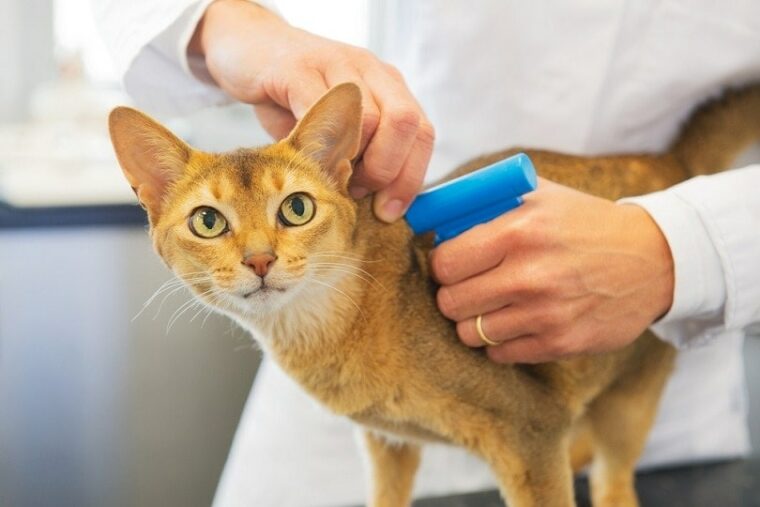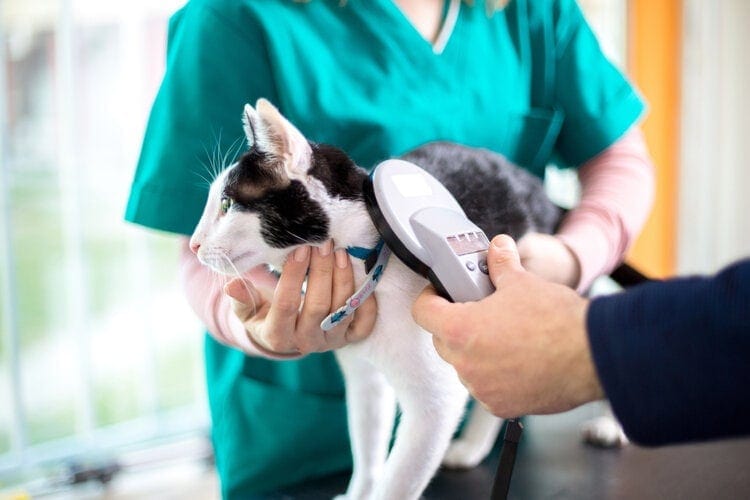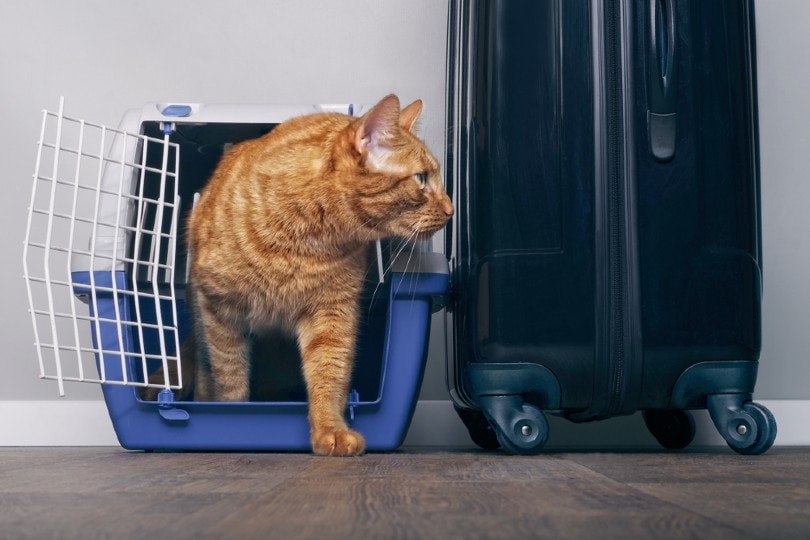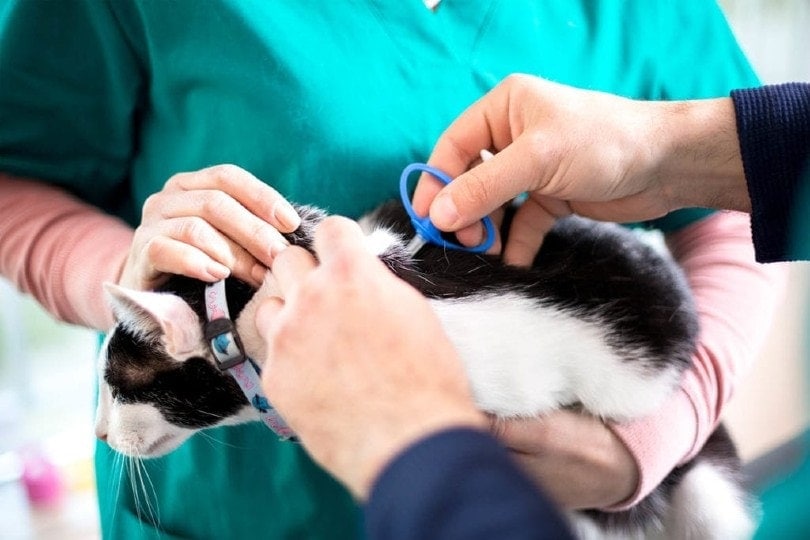
Click to Skip Ahead
If you’re planning to adopt a cat or kitten, you’ll most likely be offered the opportunity to have your pet microchipped when you take your new companion for their first veterinary visit. As a cat parent, you want the best for your cat, which means making good choices regarding their health and welfare.
Microchipping involves placing a tiny chip in the loose fur on the back of your cat’s neck. When properly set up, these chips contain information that can be used to identify your pet in an emergency. While they are a great option and increase the chances of your pet being safely returned, the technology is far from foolproof. So, what are the cons of microchipping?
Chip readers can malfunction, and you need to take steps to enroll your cat’s chip in a registry with access to your contact information. The chips can be used to identify your pet, but they don’t have your contact information encoded. Also, you may need to have another chip inserted if you travel internationally with your feline. Read on for six things to consider when deciding whether to microchip your cat or not!
Pros of Microchipping Your Cat
1. The Microchipping Process
It only takes a second to microchip a cat. A veterinarian uses a needle to insert a rice-grain-sized chip into the skin between your pet’s shoulders. It’s comparable to your buddy receiving a vaccination. After the chip is implanted, the veterinarian checks to ensure it’s working.
Most cats adopted from shelters are chipped at the same time they’re neutered or spayed. If you decide to purchase a kitten from a breeder, check to see if they plan to chip your new family member or if this is something you’ll need to take care of. The procedure can cost anywhere from $100 to $300, but several organizations provide no or low-cost chipping. And it’s often included as part of the shelters’ kitten adoption fees. While most accident and insurance plans won’t cover microchipping, some kitten-centered wellness options do.

2. Online Registries
A microchip contains a unique identifier that makes it easy to identify your pet. But microchips don’t contain information about you. Nothing on your pet’s chip can be independently used to link your cat to you. For these chips to work, pet parents need to sign their pets up for an online registry.
When enrolling in an online registry, you’ll submit your pet’s unique chip identifier and contact information. Without the registry link in place, a microchip alone won’t do much to get your pet back if they get lost. Many chipmakers have registries that offer free signup for pets with a chip made by that manufacturer.
The first three digits of the microchip identify the product’s manufacturer. Some veterinarians will take care of your registration process after chipping your cat.
3. Lost Cats
Cats get lost for all sorts of reasons. Indoor cats sometimes escape, wander off and have trouble finding the way home. Pets can also get lost in emergencies such as fires and hurricanes. And if you decide to let your pet outside, a microchip provides an extra bit of safety by making it easier to find you in an emergency.
While microchips aren’t absolute guarantees that your pet will be quickly returned or you’ll be contacted immediately in case something tragic happens, the technology creates an additional layer of protection if something happens to your pet. Most shelters and veterinarians in the United States have Radio Frequency Device (RFD) readers that work with almost all microchips.
As long as you’ve registered your pet’s unique identifying number and your contact information with a registry, any shelter or veterinarian in the US will be able to contact you if your pet is found and brought to them.

Cons of Microchipping Your Cat
4. Pain and Infection
The microchipping process appears to annoy cats about as much as getting a vaccination, and veterinarians have reported few side effects. If you’re worried about the procedure hurting your cat, speak with your veterinarian about having the microchip implanted at the same time your cat is neutered or spayed and under anesthesia.
Side effects are rare, although there have been some reports of localized tenderness and the development of the occasional abscess at the injection site. You can get your pet microchipped when they reach 10–12 weeks old, and your veterinarian can take care of the process during a regular checkup. Microchips are passive; they don’t send signals or require a battery to operate. Nor do they have chemicals known to be harmful to your pet. They don’t wear out or need replacement, and they’re less painful than tattoos and easier for shelters and veterinarians to use for reunification and notification purposes.
5. Travel

Unfortunately, you may need to re-chip your pet if you plan to take them with you on a trip to the European Union. The EU requires pets to have ISO-compliant chips. The US has different requirements, so your US microchip won’t be readable by EU customs officials, veterinarians, or shelters.
You may need to have your pet revaccinated after they receive the new chip, which can add at least a few weeks to your departure time. Check the latest EU regulations regarding microchipping before purchasing your ticket, and consider consulting with a USDA-accredited veterinarian early in the process to get good guidance about how to get all your pet’s paperwork ready.
If you’re moving to the EU, you’ll need to register your pet’s new microchip with a European registry. Your new veterinarian will make a note of your cat’s microchip number during your first visit. You’ll need an EU Pet Passport to travel within the EU with your cat.
6. Other Safety Precautions
Microchipping isn’t enough to keep your pet safe. RFD scanners can malfunction when reading a chip, and it’s always good to have a backup plan for your pet’s safety. Consider purchasing an inexpensive ID tag you can attach to your buddy’s collar. If your cat hates dangly things, look for an option where you can have your contact information engraved or embroidered directly on the collar.
There’s no need to spend time searching for a scanner in an emergency, as your contact information will be upfront and easy to find. If your cat wanders off, a collar with your details may prevent a traumatic shelter trip.

Conclusion
Microchipping your cat increases the odds that your pet will be returned safely if they escape and get lost. If you’ve enrolled in an online registry, any veterinarian or shelter with a chip reader will be able to get in touch with you. However, unregistered microchips won’t do any good when reuniting you and your buddy, and if you’re planning on traveling internationally, microchipping is often an absolute requirement. To boost the chances of recovering your pet if they wander off, don’t rely solely on a microchip. You can attach an ID tag with your contact information to your pet’s collar.
Featured Image Credit: Ivonne Wierink, Shutterstock







